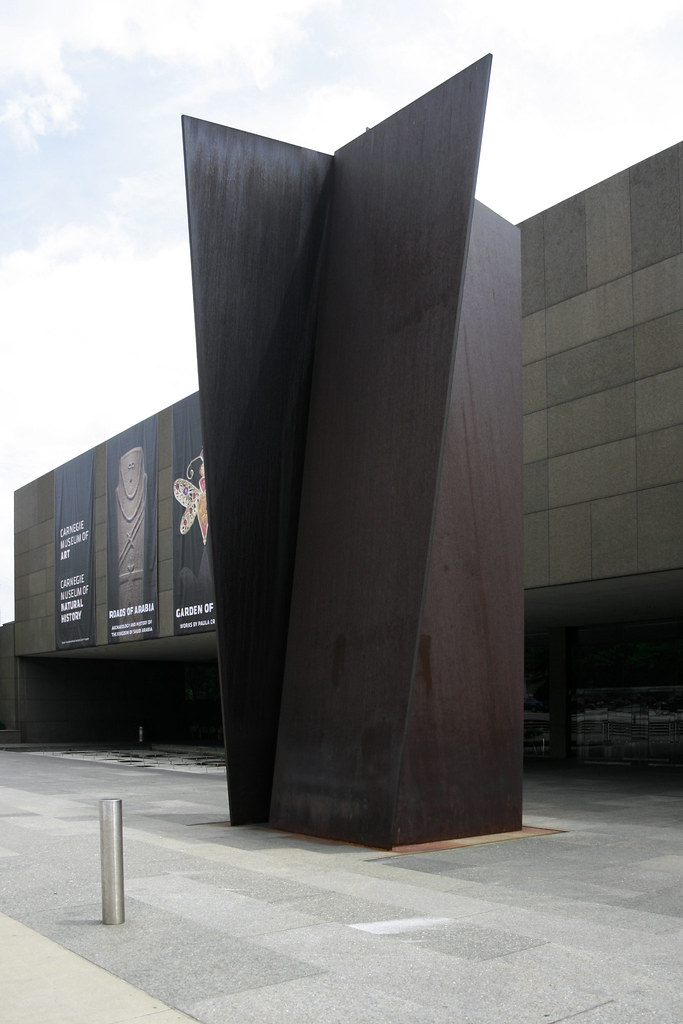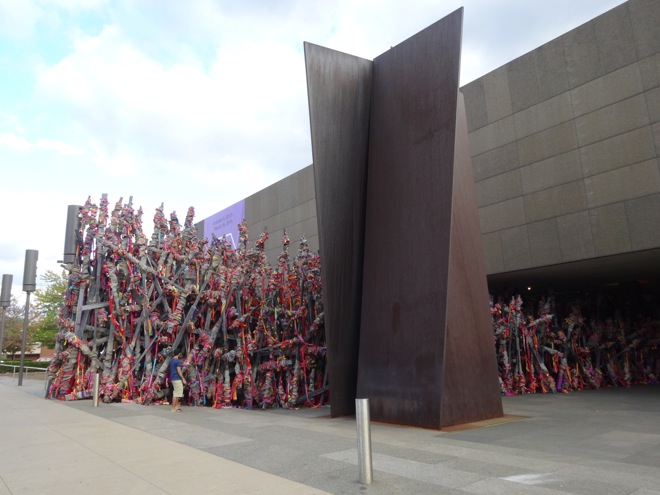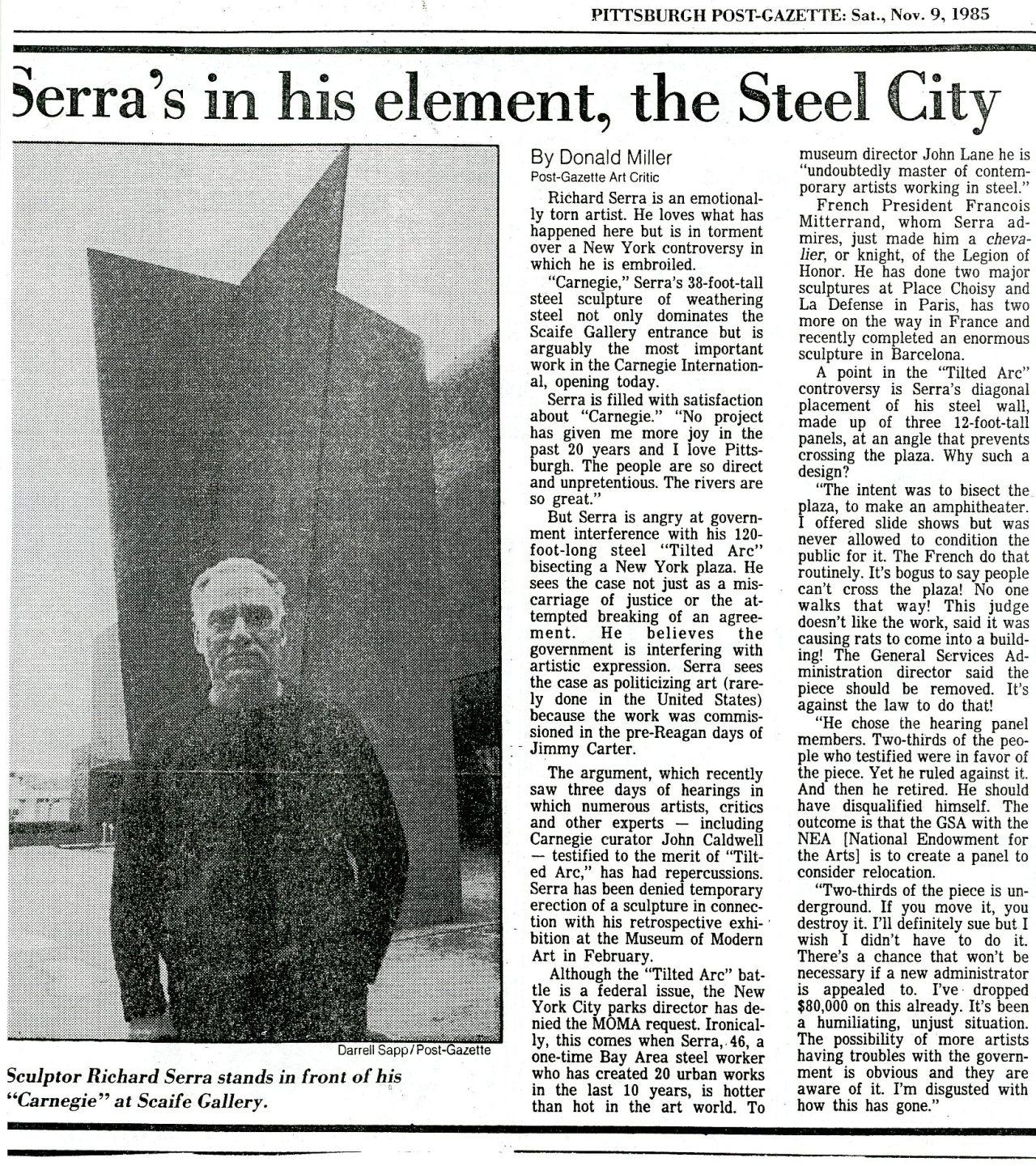I am teaching an upper level undergraduate on Rhetoric and Culture, with the theme of public art and the city. After reading about urban planning, power relations, signage, and South Africa over the first two weeks we now take our first explicit steps towards grappling with the "why public art" question, which takes us to debates about site specificity.
The arguments have been often rehearsed. And yet, they continue to be relevant. Kant's dictum that art offers a space of free play and reflection, rather than a space of political demands, has been rearticulated throughout the ages as the idea that art is a realm that is outside of politics, even part of the commodity form or the bourgeois interior, and timeless.
In the 1960s minimalist sculptors sought to reconfigure the art object's capitulation to commodity markets by being wholly self-contained by exploring the dependency that form has on its surrounding space, a "critique of idealism...and its illusory sitelessness..." (Crimp 154). This formal experimentation later gave way, and intersected with, institutional critique, and radical uses of site specificity, which sought not only to expose the always already ideological character of the museum and gallery, but to make that part of the meaning of the work, a meaning that is borne out of the relation that the art object has with its site, and its audience. Both institutional critique and early expressions of site specificity offer resistance to the dominance of logics of consumption, and yet, it is through the the former that we can also see an evolution in how we define the three key elements of a site specific work 1) space of the art (site); 2) audience; 3) the work, out of which variable meanings are made.
In On the Museum's Ruins Douglas Crimp revisits the 1981 controversy over Richard Serra's site specific sculpture, "Tilted Art," installed and then removed from Federal Plaza in New York City. In this text, Crimp revisits the history of site specific art, beginning with Robert Morris' exposition in a warehouse on Manhattan's Upper West Side in December 1968, where he displayed a strange amalgamation of objects that seem to negate "every expectation regarding the form of the work of art and the manner of its exhibition." Crimp then brings us to another element of the exposition, Richard Serra's "Splashing," a fold between wall and floor upon which Serra had thrown molten lead (150-151) In this early moment, site specificity robustly meant "to remove the work meant certainly to destroy it" (151). However, the shock that Crimp imagined audiences experiencing in 1968 would result in knowing glances in the present, a moment when site specificity has wholly saturated the art world as well as urban design. Moreover, this definition of site specificity is misleading, Crimp emphasizes. Indeed, he argues, it was this argument that Serra parroted over and over again in testimony about "Tilted Arc," but it misses the point. "Titled ARc" was "in conflict with its site," a conflict that Crimp later argues, is not negative (153). Indeed, he explains, "The specificity of Tilted Arc's site is that of a particualr public place. The work's materiality, scale, and form intersect not only with the formal characteristics of its environment but also with the desires and assumptions of a very different public from the one conditioned to the shocks of the art of the late 1960s. Serra's transfer of the radical implications of Splashing into the public realm, deliberately embracing the contradictions this transfer implies, is the real specificity of Tilted Arc." (154)
Serra's work offers a kind of materialist critique, per Crimp, by highlighting the "processes and divisions of labor"; "art's tendency toward the conditions of consumption"; and "the false separation of private and public spheres in art's production and reception." (157) Serra produces industrial works, works that require manufacturing by parties other than the artist, making it difficult to romanticize his role, as he is more contractor than Master, and, the scale and massiveness of the works throw into relief the limits of art spaces, as well as the fact that the work is not the product of a private studio (159). In this sense, Serra's work defines the public as that which is not private. But it also does something more. It is a disruption of the "bourgeois interior." Crimp notes: "If the historical form of the modern artwork was conceived for its function in adorning that private interior space, if the museum goer could always imagine the painting by Picasso or the sculpture by Giacometti transposed by inside the private dwelling, it was hardly so comfortable thought to imagine a steel wall slicing through one's living room." (160) Serra brings the street "back into the gallery," by showing the "gallery's limitations, of the stranglehold it exerts on the experience of art. By turning the tables on the gallery, holding the gallery hostage to sculpture, Serra defies the gallery's authority, declares it a site of struggle." (162).
It is precisely this struggle in which Tilted Arc's specificity lies. It emerges as a "political specificity." It is not adornment, but rather a "critical reading of the sculpture's environment" (168). His work resists symbolicity, positive identification, and agreement with its site. In yet another controversy, over a project Serra had done for Bochum, called Terminal, the Christian Democrat Party acerbically criticized these elements of the work. However, for Serra to have created a sculpture that enabled easy identification, he would also have smuggled in "the requirement that the artist symbolically reconcile the steelworkers to the brutal working conditions to which they are subjected. Steel, the material that the citizens of Ruhr district work with daily...is [for those against the sculpture] to be disguised, made unrecognizable to those who have produced it. Serra's work flatly refuses this implicitly authoritarian symbolism...instead, serra presents the steelworkers with the very product of their alienated labor, untransformed into any symbol at all. if the workers are then repelled and heap scorn on Terminal, it is because they are already alienated from the material...the CDU is really asking the artist to provide a symbolic form of consumption...to think of the worker as...a consumer." (173)
Here, I think, we reach the crux of Crimp's argument about Serra, which is that the generativity of Serra's site specific works is that they work in conflict with the site and inspire alienation, which reveals larger structures of alienation at work.
And yet, one could not make exactly the same argument about Serra's later site specific installation "Carnegie" installed in front of the Carnegie Museum of Art in Pittsburgh. In Pittsburgh, too, steel is a material of alienation, complex and violent labor histories, and part of ongoing legacies of environmental destruction and generational health issues. However, does Carnegie, a one story tall geometric spiral incite the same feelings of alienation, and subsequently, the same conflict with its socio-spatial site?
Certainly Serra's "Carnegie" is less affirmative and symbolic than George Segal's "The Steel Workers" in nearby Youngstown Ohio, which presents two workers in conversation (174)
While Segal's work is narrative and figurative, offering a snapshot of worker life in an impressive steel structure, in Serra's rendering we have four rusted folds of metal, like a piece of origami, leaning on each other to create a narrow base that opens up, like an unfolding metallic bulb. there is a narrow entrance to the sculpture that one can squeeze through, where, once inside, it is clear that the volume inside diminishes as it rises, leading to a narrow window. It is a claustrophobic space, but also perhaps a space of refuge.
Serra completed "Carnegie" in 1985 during the end of the "Tilted Arc" controversy, and, in Steel City, Serra expressed his happiness and satisfaction with the Carnegie piece, for Pittsburgh's rivers, for the directness of its people (Miller 1985)
Somewhat ironically, Serra is in harmony with this site. And so, what kind of specificity is being offered?
Here Miwon Kwon's chronology of site specificity and her different definitions are extremely useful. The early definition of site specificity, she offers, is the "dramatic reversal" of the modernist paradigm that the art was self contained, "site specific art, whether interruptive or assimilative, gave itself up to its environmental context, being formally determined by it." (85)
This first definition also assumes that were the work moved, it would be destroyed. (86) This definition also assumes that the embodied experience of encountering the object is central, a phenomenological approach. This understanding is most often applied to Serra's work, and as such, one could read "Carnegie" as site specific insofar engaging with it subjects the corpus to variable experiences of equilibrium and disequilibrium through its diagonal verticality. The second definition of site specificity understands the site to be cultural, rather than physical. (87) Minimalism was phenomenological, and institutional critique "insisted on the social matrix of race, class, gender, and sexuality of the viewing subject," also showing the "ideological function" of the museum space as well as the economies of the studio, museum, gallery, art history, art market, etc. (88) In this second iteration the site os the "techniques and effects of the art institution as they circumscribe the definition, production, presentation, and dissemination of art that become the sites of critical intervention." (89) Sites have also extended, over time, beyond the gallery to schools, prisons, streets, and so forth, and also media spaces. Moreover, the "site" has received a third inflection as it more and more assumes the "discursive" site of the work-- academic disciplines, epistemological arrangements(92). The "work" might involve mapping, a process, an itinerary, a "nomadic narrative" which "textualizes spaces and spatializes discourses." (95) Within the three definition (phenomenological; social/institutional; discursive) there are of course overlaps and oscillations.
However, site specificity is becoming more mainstream, tailored and reintegrated into the museum, and repeated by celebrity nomadic artists, "'Moveable under the right circumstances,' shattering the dictum 'to remove the work is to destroy the work.'" (97) As such, site specificity is commodified often recharacterized as the issue of a particular artist preference rather than a critique of aesthetic experience, and, for Kwon "active processes are transformed into inert objects once again. In this way, site-specific art comes to represent criticality rather than perform it. The 'here-and-now' of aesthetic experience is isolated as the signified, severed from its signifier." (98)
It is here we might begin to understand how 'Carnegie' might be site specific insofar as it is the issuance of a celebrity artist, one that "represents" the critical rather than enacting it. Kwon's distinction between representation and performance is critical. It helps us understand site specificity, while inhering in a variety of sites, is anchored in its performativity. It does something to space/bodies/language/cultural constructs. It is not representative, it is agentive. To return to Serra's 1968 "Splashing" piece, it is not site specific only because moving it would destroy it, or, because it functioned as a conflict with the precepts of the gallery as blank space, but also because it was already dead and gone after the action of splashing the molten lead. It was already a residue. In order for ostensibly permanent site specific works to retain their specificity they must maintain their activity and they do so in concert with the dynamics of their spatial/discursive/cultural location and their various audiences.
However, Kwon, suggests, it is such a valorization of singularity that is dangerous, given that cities are increasingly marketed for their uniqueness, a refetishization of place as "the locus of authentic experience and coherent sense of historical and personal identity." (104) Now, "the current socioeconomic order thrives on the (artificial) production and (mass) consumption of difference (for difference's sake), the siting of art in 'real' places can also be a means to extract the social and historical dimensions out of places to variously serve the thematic drive an an artist, satisfy institutional demographic profiles, or fulfill the fiscal needs of a city." (105)
When Serra made "Carnegie" in 1985 he was already the artist as 'globe trotter' that Kwon presages the objectification of the artist even as the works are tailored to (several) locations. (101) In this sense, the "performative aspect of an artist's characteristic mode of operation...that is repeated and circulated as a new art commodity, with the artist functioning as the primary vehicle for its verification, repetition, and circulation." (102) However, I think that the "performative" aspect of the artist is not one that is specific, it is, above all, repetitive, and anchored to what has become a characteristic style. So, even though Kwon helps us understand that the performative can be repeatable, and consumed, there is something about the status of the work as a process rather than inert object that is important, and not clearly present in "Carnegie." "Tilted Arc" created a process of controversy and dialogue, "Carnegie" ended in sanctification.
Even so, it is not forever dead. It was playfully resurrected in Phyllida's Barlow's temporary "Tip" installation in 2013, a caterwauling expanse of boards covered in colorful fabric dancing across the plaza and grazing "Carnegie," poking fun at its hard, stolid, rusty planes. It is, to a degree, a goofy rebuke to the sanctity of "place making" and sincere gestures towards "community." Moreover, "Carnegie's" austere planes and seeming place-less character also refuses to buy into or sustain discourses of local authenticity (and difference).
Indeed, it creates a new dialogue in the plaza, one between quirky, hyperfeminized international urbanism, and minimalist, regal gestures to permanence and directionality. It also seems appropriate, as we are now a few decades out from the industrial industry collapse that struck Pittsburgh in the 70s, and in the thick of Creative Cities and IT city redevelopment. Does this presage a new mode of Rust Belt site specificity? Does "Carnegie," with its somber lines, offer a model of site specificity by virtue of its very refusal to buy into the ideology of uniqueness, its shrug in the face of "melancholic discourse" about site (106)? Or, is it just further evidence of "dissipation of the site...the 'dynamics of deterritorialization'"? (107) Is it a way to be "out of place" "a terrain between mobilization and specificity" (109)? I think it is only in interventions such as Barlow's that "Carnegie" can bring the viewer into a consciousness of its "relational specificity" (110) and the distances between one place and another.
Works cited:
Crimp, Douglas. On the Museum's Ruins. Cambridge, MA: MIT Press, 1993.
Kwon, Miwon. "One Place After Another: Notes on Site Specificity" October 80, Spring (1997) 85-110.




No comments:
Post a Comment